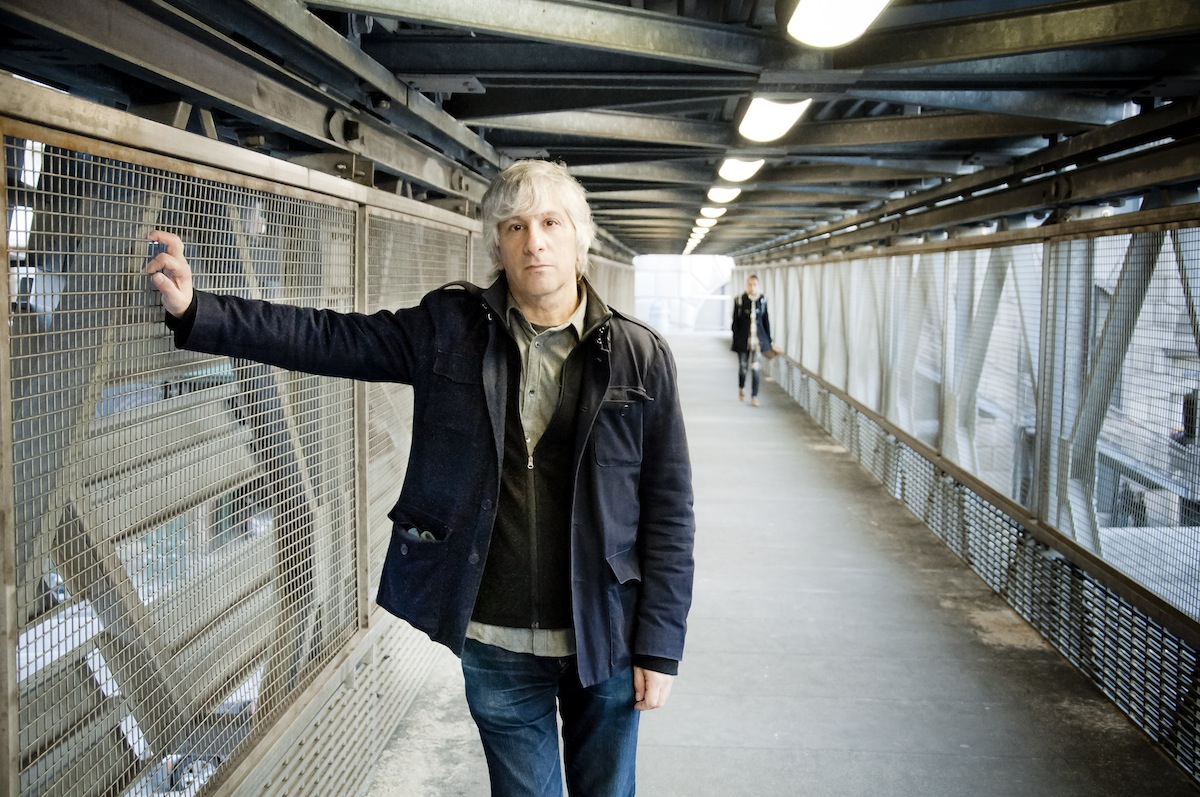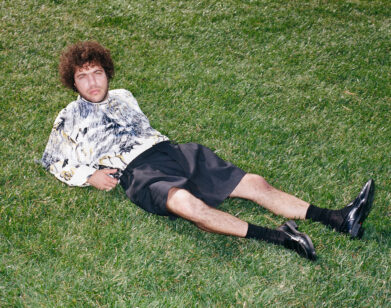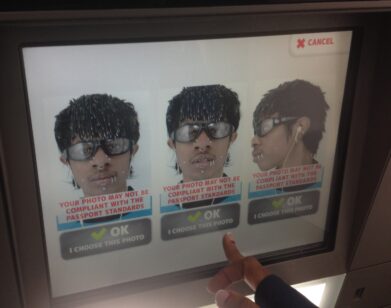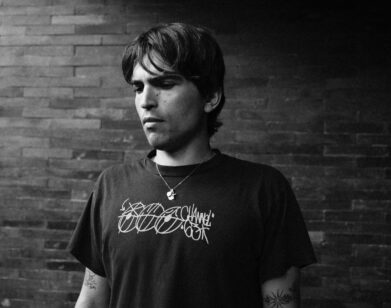Lee Ranaldo’s Mirror Reflections

IMAGE COURTESY OF STEFANO GIOVANNINI
It’s September 11, and Lee Ranaldo is in a contemplative frame of mind. Speaking from his home not far from Ground Zero, he’s joined by his wife, photographer/artist Leah Singer, and sons Cody and Frey. The long-time Sonic Youth guitarist, record producer, and writer made time in his schedule to discuss his past and current career, as well as the tragedy that so affected his hometown and the world.
After Sonic Youth went on indefinite hiatus last year, Ranaldo began to work on his own material. He released a solo album entitled Between the Times and the Tides in March. The release has an unhurried, musicianly vibe that reflects its genesis. As he explains it, he simply picked up some acoustic guitars lying around his house and started to play. “For the first time in a while, I was really enjoying playing for the sake of it,” he says. “Every time I picked up the guitar, I thought, ‘God, I need to write another song.'”
Ranaldo toured in support of the release earlier this year with his backing band, which includes Sonic Youth bandmate Steve Shelley on drums and longtime collaborator Alan Licht on guitar. This month, the ensemble will perform at the Greg Dulli-curated I’ll Be Your Mirror, the New York leg of international festival series All Tomorrow’s Parties, and they have tentative plans to record another album in 2013.
DANIELLE BACHER: What made you want to record a song-based solo album (Between the Times and the Tides) with original lyrics?
LEE RANALDO: It’s something I’ve wanted to do for a long time. I’ve tried to do it before, but I was never in the right headspace or quiet space to do it. It kind of happened by surprise. I wasn’t thinking about making a record like this; the songs just started coming out. Before I knew it, I had enough songs to make a record. It’s a very personal thing, and I wanted to capture that vibe. It’s fulfilling as much as it is a dream.
BACHER: The musicality, for lack of a better word, of your new album is disarming, especially in comparison to your previous solo releases. Do you think any of these songs would have ended up on a new Sonic Youth album if the band had gone back into the recording studio?
RANALDO: That’s possible. Certainly, that’s how songs that I brought in ended up on Sonic Youth albums to begin with. In a way, these songs were allowed to breathe because they weren’t sent through the fan machine. When Sonic Youth writes music, we write everything in a very communal way. It doesn’t matter who brought something in initially, it all gets transformed by the band. In this case, I was making decisions, and I wanted them to have a certain kind of simplicity. They ended up more personal for that reason.
BACHER: You worked with a tremendously talented and disparate group of musicians (Nels Cline, Steve Shelley, Alan Licht, Irwin Menken, John Medeski, Jim O’Rourke) on your album. How did they influence you in the songwriting and recording process?
RANALDO: Not so much the songwriting, but the arrangement and construction of the finished songs. My criterion for the record was playing with people I’m really comfortable around and whom I thought would support the project. I’ve played with Alan and Nels a lot over the years. I’ve played a lot with Medeski, too. When I had all the songs together, the one thing I thought was, “I really want a lot of keyboards and organ on it.” I wanted John to do it because he is just the best. He really brought an interesting take to some of the songs.
BACHER: Who was the inspiration behind the “Xtina” in “Xtina as I Knew Her” on your latest album? When I see that name spelled that way, I cannot think of anyone but Christina Aguilera.
RANALDO: Oh, no. It’s not Christina Aguilera. It’s nobody famous. It’s just somebody I knew growing up. It’s an amalgam of a couple of different people, actually. It’s funny; I worked really closely with this Spanish singer named Christina Rosenvinge. I produced and played on a couple of her records. Some people thought it was about her, but it’s not about anybody you would know of.
BACHER: Sonic Youth is on an indefinite hiatus. Has the band discussed its next collective move?
RANALDO: Not in the least. I doubt we will discuss anything about the next move in terms of new performances or recordings or anything like that. We’re moving ahead with certain archival projects. We’ve got a project that was just announced yesterday, our Chicago record that we’ve been working on for a while. There’s a bunch of other archival stuff like that. We’ve spent a lot of time getting our archives in shape and digitizing everything. We’ve got tapes that go back 30 years and cassettes that are in drawers and boxes. We might do a series of live records.
BACHER: Yeah, I just read that Sonic Youth is releasing a “new old” live album recorded in 1985. What stands out most about the band and its performances from that era?
RANALDO: That gig was like a week or two into the first tour Steve did with us. Sonic Youth was shifting gears. We were still performing Bad Moon Rising material, and we were just getting ready to start recording EVOL. It might have been the first real US tour we did. It’s a pretty good document of mid-’80s Sonic Youth, but it’s not the really sophisticated interplay. We were kind of working toward that.
BACHER: Has Thurston and Kim’s separation affected the intraband dynamic at all, or have you not yet spent enough time together to tell?
RANALDO: I think it’s mostly affected the intraband dynamic between the two of them. It really hasn’t affected my dynamic with either of them or with Steve. Steve plays in my solo band, so we hang out a lot. I talk to each of them as well, probably as much or more than ever.
BACHER: How did you get involved with I’ll Be Your Mirror/All Tomorrow’s Parties?
RANALDO: Basically, we go back a long way with Barry Hogan, the guy behind the festival. You know, when he first started doing it, the concept of ATP was that the audience and the musicians live on the site for three or four days, and it would be curated by someone you admire. Sonic Youth curated a couple, and I have to say ours were really, really good. I’ll be Your Mirror is a slightly different thing. It’s a little bit more like a regular concert, but there is this sort of knowledge that they generally have really good taste, and it’s probably on the more interesting side of what you see at a festival.
BACHER: Do you have any crazy or interesting stories from your solo tour earlier this year?
LEE RANALDO: [asks his son Cody] Did we have any crazy or interesting stories on tour?
CODY RANALDO: [answers, but it’s too distorted to hear]
LEE RANALDO: Was it about what’s-his-name? [laughs] Yeah, uh, I guess the craziest, most interesting story I can’t really get into.
BACHER: What about a crazy Sonic Youth story?
RANALDO: One of the craziest stories ever was in the early- to mid-’80s. We were in Europe, playing in this little bar, and this guy was acting really insane. He was becoming weirdly agitated by what we were doing onstage. We didn’t really know what his deal was. He ended up on stage while we were playing, and we tackled him and tied him up with gaffer tape. We actually bound his feet and hands and finished the song. He was rolling around on the stage. When the song was over, he started to have an epileptic fit or something. It was truly a weird occasion.
BACHER: How has the New York music scene changed since your days back in the “No Wave?”
RANALDO: It’s changed, and it hasn’t. New York always has a lot of creativity going on. The scene was much smaller at that point. You don’t work in isolation anymore. Anybody can write a song and put it up on the Internet the next day. Back then, it could take years to disseminate. You know, it was an incredibly artistic scene at that time. But New York is always full of creative people doing interesting things. That hasn’t changed.
BACHER: In my experience, veteran musicians often have an unusual or esoteric hobby (e.g., Neil Young and his model trains). What do you do to unwind in your down time?
RANALDO: [laughs] I ride a bicycle. I make artwork and do other kinds of stuff—but in terms of unwind, I like to play tennis and ride. I just had this New York century ride a couple days ago. I rode 80 miles with a buddy of mine.
BACHER: Damn. You must be in really good shape.
RANALDO: Yeah, it was pretty insane.
BACHER: Today is September 11. Your studio and home were in Lower Manhattan. What does this day mean to you?
RANALDO: Yeah, it’s September 11, and I live around the corner [from Ground Zero]. I’ve been thinking about it all day, especially since people have been talking about it. I was talking to my friend during our long bike ride, and we were discussing it a little bit. The oddest thing about it is whenever you see it—because they’re always reviving that footage on this date—whenever I see all that footage, it’s all my neighborhood.
BACHER: Is it difficult for you to watch?
RANALDO: It’s like every shot is, “Oh, I know that building. I know that building. That’s around the corner. That’s around the other corner.” All these places I’ve lived near for 20 or 30 years. It’s really weird on that level. I’m affected in a different way because I’m a resident of the area. It’s always an unusual thing. I was reading something in the Times today. It was some article on the editorial page. [pauses] Oh God, I don’t think I can really talk about this subject anymore.
BACHER: There is talk that Sonic Youth might be inducted into the Rock and Roll Hall of Fame in 2013. Is that something you really care about?
RANALDO: Is there really talk about it? [laughs] I haven’t heard that. I don’t think it’s anything we are holding our breath over. It was fun to see the Beastie Boys inducted, though. But to answer your question: No, we’re not losing sleep over it.
LEE RANALDO AND HIS BAND ARE PLAYING SUNDAY, SEPTEMBER 23 AT PIER 36, MANHATTAN.






